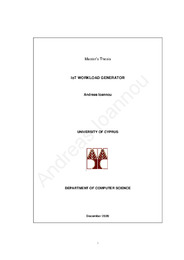IoT Workload Generator

View/
Date
2021-02-22Author
Ioannou, Andreas G.Publisher
Πανεπιστήμιο Κύπρου, Σχολή Θετικών και Εφαρμοσμένων Επιστημών / University of Cyprus, Faculty of Pure and Applied SciencesPlace of publication
CyprusGoogle Scholar check
Keyword(s):
Metadata
Show full item recordAbstract
Nowadays, the novel IoT application era has risen to the top, reaching a point that smart devices can also communicate between them. This new era introduced the need of continuous information exchange between the smart devices, which has as result that IoT applications produce vast amounts of data that need processing, and some of the applications require this processing to be of low or ideally no latency. The Fog and edge computing paradigms had emerged from these demands, as a solution, bridging the gap between users’ applications and the cloud by providing intermediate processing nodes, closer to the user application, that minimizes the processing latency, which is essential for time-critical applications.
Deployment of fog systems can be really complicated, and it demands effort, time and costs, making the life difficult for users that would like to test or evaluate their IoT applications. The solution for this challenge is the paradigm of fog emulators, along with workload generator softwares. With an IoT workload generator integrated with a fog emulator, users can produce or replay sensor data based on their sensors’ model description, and evaluate their applications with real IoT devices scenarios, by emulating real sensors easily, and without the need to purchase and set the real infrastructure.
This thesis introduces a novel IoT workload generator that (re)produces data from IoT devices in order for the users to be able to stress, evaluate and test their applications easily. Users can provide sensor models information, or recorded sensor data through datasets and the system will replay or produce new sensor messages data stream straight to the user’s application. The implementation provides a comprehensive sensor model realization, along with a scalable, extendable and heterogeneous workload generator that gives the ability to the users of IoT applications to produce IoT data stream to their applications based on the user's input sensors configurations, regardless of the output data protocol or message format. On top of that, users can provide datasets of recorded real data that can be reproduced, with the ability to be customized, regarding the user’s preferences, and finally they can implement the existing input and output interfaces for new features matching their specific needs.
